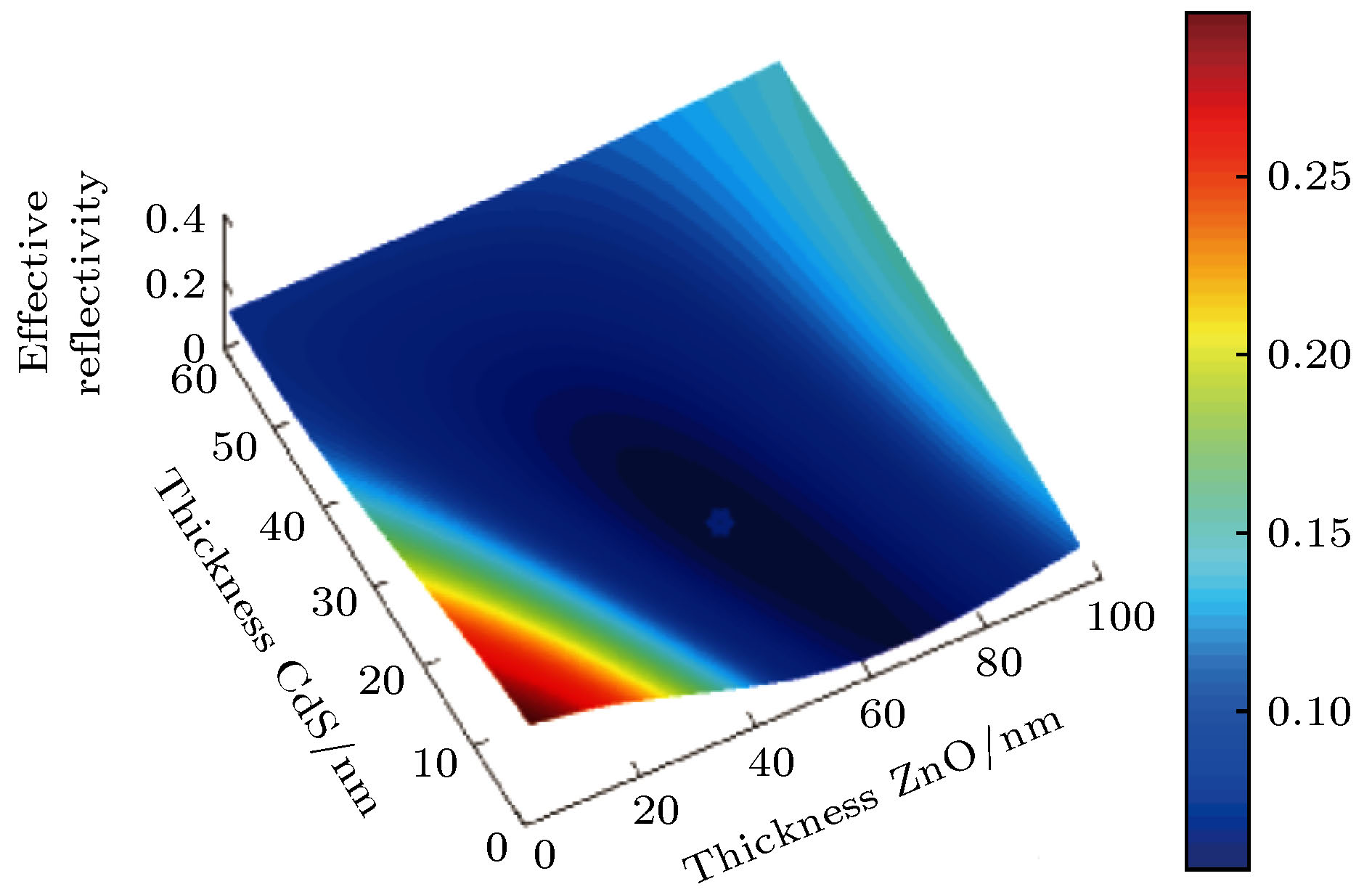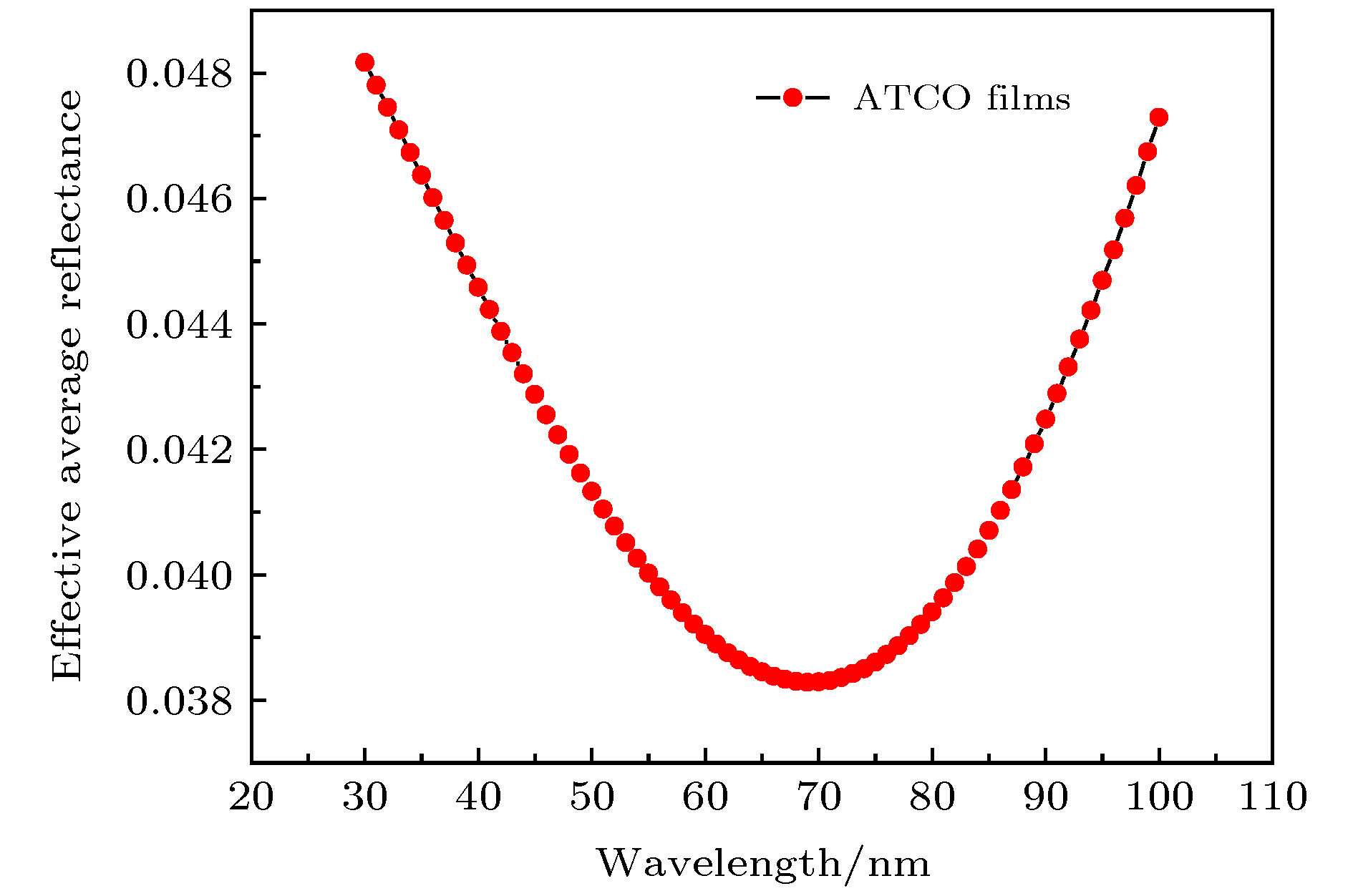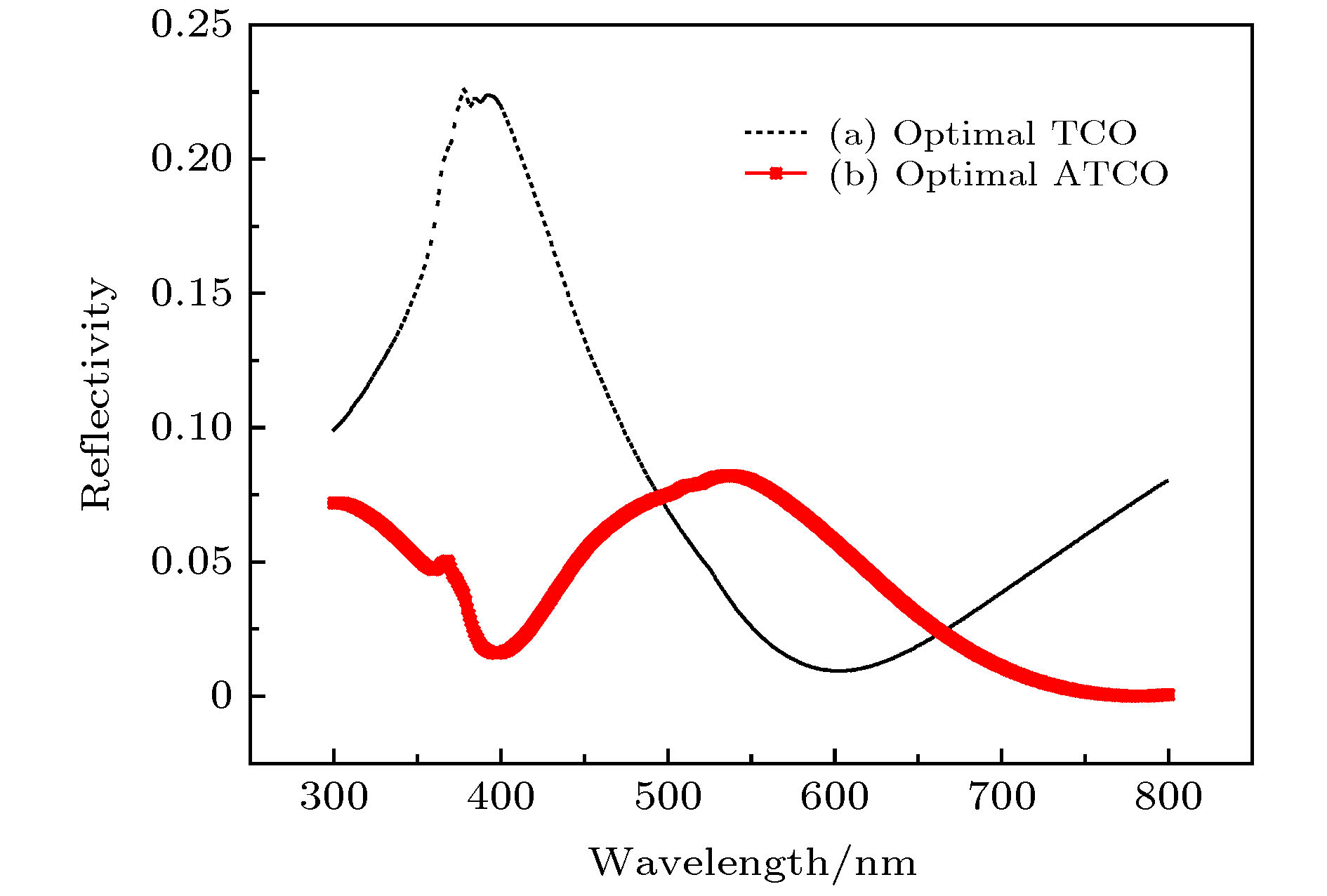-
通过研究一种新型透明导电氧化物薄膜(transparent conductive oxide, TCO)的减反射作用, 探索增加入射光进入Cu2ZnSnS4 (CZTS)太阳能电池从而提高太阳能电池效率的新途径. 在AM1.5光照条件下, 设计了一种在宽波长范围内具有更好的减反射性能的TCO薄膜, 即SiO2/ZnO减反射TCO薄膜(antireflective transparent conductive oxide, ATCO). 为了衡量300—800 nm波长范围内的减反射效果, 引入了有效平均反射率方法(effective average reflectance, EAR)进行测算. 为充分考虑折射率色散的影响以及TCO, ATCO薄膜与有源层的耦合, 本文采用多维光学传输矩阵对各关键材料层的耦合及膜厚进行了优化, 以准确衡量最优的减反射效果. 最后, 通过比较常规CZTSSC和ATCO-CZTSSC的减反射性能, 得到了新型ATCO膜, 可以有效地减少光损耗并提高光电转换效率的结论.
-
关键词:
- 减反射膜 /
- 透明导电氧化物 /
- Cu2ZnSnS4太阳能电池 /
- 有效平均反射率
At present, there are several kinds of broadband antireflection coatings (ARCs). For the flat multilayer ARC, it usually contains double, triple, or up to 4 layers. It has been demonstrated that the performance of a single layer coating is not good enough across the desired spectral range. Multiple layer ARCs have much better performance for broadband solar cells (SCs). When inspecting the antireflection structure of Cu2ZnSnS4 solar cells (CZTSSCs), it is shown that the transparent conductive oxide (TCO) of traditional CZTSSCs does not have an satisfactory antireflective performance. This paper aims to investigate a way to increase the incident light transmitted into CZTSSCs, and thus improving the efficiency of solar cells by studying the use of the antireflective effect of a TCO film. It introduces a new type of TCO film with better antireflective properties across a wide wavelength range. An SiO2/ZnO antireflective TCO (ATCO) is designed under AM1.5 illumination. In order to measure the antireflective effect over the 300–800 nm wavelength range, an effective average reflectance method (EAR) is introduced. Considering the effect of the refractive index dispersion and the coupling of the TCO or ATCO films with the active layer, in this paper we use a multi-dimensional transfer matrix to optimize the thickness of each key layer to accurately confirm the best antireflective effect. In addition, the optimized TCO film and the optimized ATCO film in CZTSSCs are compared and analyzed by means of EAR. The result shows, through the comparison of the antireflection between conventional TCO CZTSSCs and ATCO CZTSSCs, that there are considerable differences in final optimal reflectivity between TCO layer and ATCO film. For the conventional CZTSSC, the optimal effective average reflectance of TCO layer is 5.6%, and the lowest reflectivity in the waveband from 400 nm to 500 nm is 6.9%. In addition, the corresponding values obtained in the new ATCO CZTSSC are 3.8% and 1.6% respectively. These apparent changes in reflectivity are appealing in that the new ATCO films can effectively reduce light loss and improve the efficiency of photovoltaic conversion.-
Keywords:
- antireflective films /
- transparent conductive oxide /
- Cu2ZnSnS4 solar cells /
- effective average reflectance
[1] Siddique R H, Gomard G, and Holscher H 2015 Nat. Commun. 6 6909
 Google Scholar
Google Scholar
[2] Jonathan S M, Wang G Y, John R M, James R H 2018 J. Mater. Chem. C 6 823
[3] Neeraj K, Choudhury S, Polley D, Acharya R, Sinha J, Barman A, Mitra R K 2017 Opt. Lett. 42 1764
 Google Scholar
Google Scholar
[4] Cao G Y, Zhang C, Wu S L, Ma D, Li X F 2018 Chin. Phys. B 27 124202
 Google Scholar
Google Scholar
[5] Li L, Wu S L, Yu D, Wang W, Liu W C, Wu X S, Zhang F M 2016 Chin. Phys. B 25 028401
 Google Scholar
Google Scholar
[6] Jayasinghe R C, Perera A G U, Zhu H, Zhao Y 2012 Opt. Lett. 37 4302
 Google Scholar
Google Scholar
[7] Zhan F, He J F, Shang X J, Li M F, Ni H Q, Xu Y Q, Niu Z C 2012 Chin. Phys. B 21 037802
 Google Scholar
Google Scholar
[8] Leem J W, Jun D H, Heo J, Park W K, Park J H, Cho W J, Kim D E, Yu J S 2013 Opt. Express 21 A821
 Google Scholar
Google Scholar
[9] Richards B S 2003 Sol. Energ. Mat. Sol. C 79 369
 Google Scholar
Google Scholar
[10] Algora C, Alcaraz M F 1997 IEEE T. Electron Dev. 44 1499
 Google Scholar
Google Scholar
[11] Sun H T, Wang X P, Kou Z Q, Wang L J, Wang J Y, Sun Y Q 2015 Chin. Phys. B 24 047701
 Google Scholar
Google Scholar
[12] Ali B, Shahram M, Nima J A 2014 Chin. Phys. B 23 028803
 Google Scholar
Google Scholar
[13] Wang N F, Kuo T W, Tsai Y Z, Lin S X, Hung P K, Lin C L, Houng M P 2012 Opt. Express 20 7445
 Google Scholar
Google Scholar
[14] Dumont E, Dugnoille B, Bienfait S 1999 Thin Solid Films 353 93
 Google Scholar
Google Scholar
[15] Seol J S, Lee S Y, Lee J C, Nam H D, Kim K H 2003 Sol. Energy Mater. Sol. Cells 75 155
 Google Scholar
Google Scholar
[16] Park W D 2012 Trans. Electr. Electron. Mater. 13 196
 Google Scholar
Google Scholar
[17] Teng C W, Muth J F, Özgür Ü, Bergmann M J, Everitt H O, Sharma A K, Jin C, Narayan J 2000 Appl. Phys. Lett. 76 979
 Google Scholar
Google Scholar
[18] Palik E D 1997 Handbook of Optical Constant of Solids (New York, USA: Academic Publishing)
[19] Born M, Wolf E. 1999 Principles of Optics (Cambridge, UK: Cambridge University Press) p70
[20] Macleod H A 2006 ThinFilm Optical Filters (London, UK: Institute of Physics Publishing) p86
[21] Zhan F, Li Z P, Shen X M, He H, Zeng J M 2014 Sci. World J. 26 5351
[22] Yuan H R, Xiang X, Chang X, Lu D 2000 Acta Energ. Sol. Sin. 21 371
-
-
[1] Siddique R H, Gomard G, and Holscher H 2015 Nat. Commun. 6 6909
 Google Scholar
Google Scholar
[2] Jonathan S M, Wang G Y, John R M, James R H 2018 J. Mater. Chem. C 6 823
[3] Neeraj K, Choudhury S, Polley D, Acharya R, Sinha J, Barman A, Mitra R K 2017 Opt. Lett. 42 1764
 Google Scholar
Google Scholar
[4] Cao G Y, Zhang C, Wu S L, Ma D, Li X F 2018 Chin. Phys. B 27 124202
 Google Scholar
Google Scholar
[5] Li L, Wu S L, Yu D, Wang W, Liu W C, Wu X S, Zhang F M 2016 Chin. Phys. B 25 028401
 Google Scholar
Google Scholar
[6] Jayasinghe R C, Perera A G U, Zhu H, Zhao Y 2012 Opt. Lett. 37 4302
 Google Scholar
Google Scholar
[7] Zhan F, He J F, Shang X J, Li M F, Ni H Q, Xu Y Q, Niu Z C 2012 Chin. Phys. B 21 037802
 Google Scholar
Google Scholar
[8] Leem J W, Jun D H, Heo J, Park W K, Park J H, Cho W J, Kim D E, Yu J S 2013 Opt. Express 21 A821
 Google Scholar
Google Scholar
[9] Richards B S 2003 Sol. Energ. Mat. Sol. C 79 369
 Google Scholar
Google Scholar
[10] Algora C, Alcaraz M F 1997 IEEE T. Electron Dev. 44 1499
 Google Scholar
Google Scholar
[11] Sun H T, Wang X P, Kou Z Q, Wang L J, Wang J Y, Sun Y Q 2015 Chin. Phys. B 24 047701
 Google Scholar
Google Scholar
[12] Ali B, Shahram M, Nima J A 2014 Chin. Phys. B 23 028803
 Google Scholar
Google Scholar
[13] Wang N F, Kuo T W, Tsai Y Z, Lin S X, Hung P K, Lin C L, Houng M P 2012 Opt. Express 20 7445
 Google Scholar
Google Scholar
[14] Dumont E, Dugnoille B, Bienfait S 1999 Thin Solid Films 353 93
 Google Scholar
Google Scholar
[15] Seol J S, Lee S Y, Lee J C, Nam H D, Kim K H 2003 Sol. Energy Mater. Sol. Cells 75 155
 Google Scholar
Google Scholar
[16] Park W D 2012 Trans. Electr. Electron. Mater. 13 196
 Google Scholar
Google Scholar
[17] Teng C W, Muth J F, Özgür Ü, Bergmann M J, Everitt H O, Sharma A K, Jin C, Narayan J 2000 Appl. Phys. Lett. 76 979
 Google Scholar
Google Scholar
[18] Palik E D 1997 Handbook of Optical Constant of Solids (New York, USA: Academic Publishing)
[19] Born M, Wolf E. 1999 Principles of Optics (Cambridge, UK: Cambridge University Press) p70
[20] Macleod H A 2006 ThinFilm Optical Filters (London, UK: Institute of Physics Publishing) p86
[21] Zhan F, Li Z P, Shen X M, He H, Zeng J M 2014 Sci. World J. 26 5351
[22] Yuan H R, Xiang X, Chang X, Lu D 2000 Acta Energ. Sol. Sin. 21 371
计量
- 文章访问数: 8692
- PDF下载量: 104
- 被引次数: 0














 下载:
下载:




